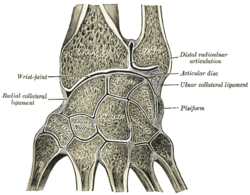Plane joint
Appearance
| Gliding joint | |
|---|---|
 Vertical section through the articulations at the wrist, showing the synovial cavities. | |
| Details | |
| Identifiers | |
| Latin | articulatio plana |
| TA98 | A03.0.00.043 |
| TA2 | 1555 |
| FMA | 75293 |
| Anatomical terminology | |
A plane joint (arthrodial joint, gliding joint, plane articulation) is a synovial joint which, under physiological conditions, allows only gliding movement.
Plane joints permit sliding movements in the plane of articular surfaces. The opposed surfaces of the bones are flat or almost flat, with movement limited by their tight joint capsules. Plane joints are numerous and are nearly always small, such as the acromioclavicular joint between the acromion of the scapula and the clavicle. Typically, they are found in the wrists, ankles, the 2nd through 7th sternocostal joints, vertebral transverse and spinous processes.[1]
References
![]() This article incorporates text in the public domain from page 286 of the 20th edition of Gray's Anatomy (1918)
This article incorporates text in the public domain from page 286 of the 20th edition of Gray's Anatomy (1918)
- ^ Moore, et al. Introduction to Clinically Oriented Anatomy. Baltimore: Lippincott Williams & Wilkins, 2006.
External links
Wikimedia Commons has media related to Plane joints.
